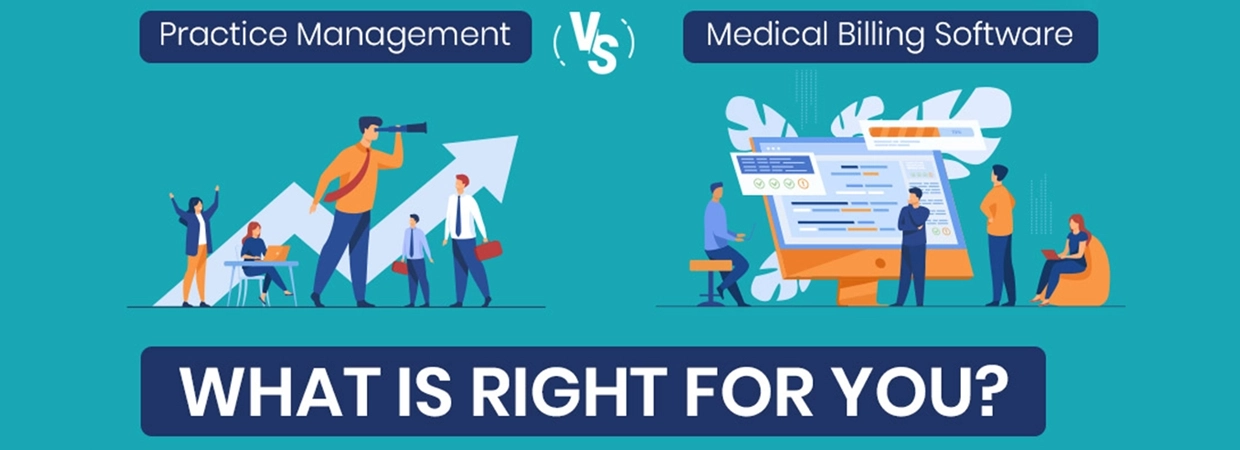Practice Management Vs. Medical Billing Software – What is Right for You?
As every healthcare practice has its own needs and goals, so is its requirement. Some want efficiency to improve; some want to streamline their claims processing to be hassle-free. At the same time, others might be more interested in notifying their patients of upcoming appointments and bill the same timely. Some might want a combination of these, and some might look for all of them.
It is fine to approach your life in whatever way you want to, but when it comes to purchasing medical billing system or practice management software, remember that you are responsible for others’ lives and health simultaneously. This is why understanding the significant disparities between the nuances of medical billing software and medical practice management software is very important.
But the one major area that is confusing for all is the debate on medical billing software vs practice management software. These two might look similar to a layman, but they are way apart regarding workflow. So, this article will focus on the significant disparities in the working of the medical billing system and the processes involved in Practice management applications.
But before stating the differences, let us understand the basic functionalities of both and then we will see the advantages of Practice management billing software.
What is Practice Management Software?
The practice management software is the application so designed to assist the medical offices in the running effectively and efficiently. In general, the small and medium-sized provider system can manage daily operations like financial processes and administrative functions, while some organizations can utilize it for electronic medical records.
The standard capabilities of any practice management software can include the following but are not limited to:
- Patient registration
- Patient tracking
- Patient appointment and its scheduling
- Tracking charge capture
- Performing the billing procedures and claim processing
- Payment processing from patients, insurance providers and third-party providers
- Generating staff reports
As PMS simplifies patient data management, the adoption of these systems has grown drastically over the last few years. According to Grand View Research, the US$12.9 billion market size value of PMS in 2019 is expected to witness an annual growth of 8.8% by 2022 to 2030.
There are three different ways to install the software: desktop-only, client-server, and Internet-based.
Desktop-only software: This can be used on a single computer by the few who can access the system.
Client-server software: This can be accessed by multiple users with data sharing and on-site server access that the practice has to purchase or lease.
Internet-based software: The user can access the internet and eliminate the server purchase pre-requisite, but this can hamper the security as patient data is accessible externally.
The Practice Management Applications also manages big data like ICD codes and procedures, third-party insurance providers, medical procedures, and providers.
Pros of Practice Management Software
The software is responsible for helping various departments in any practice as mentioned under:
Front Desk Staff
The Front Desk Staff will not duplicate the insurance card. Instead, the staff will scan the card to capture the relevant information. This will save time and human efforts at the same time.
Billing Department
The billing staff can submit and re-submit the insurance claims quickly as that software automates the tasks. This would save time and boost cash flow efficiently.
Physicians
The physicians can validate the ICD codes for the patient diagnosis and with the insurance company before ordering the same. Additionally, this software can ease the other administrative functions required while running a practice. This will allow the practitioners to continue their practice at ease without bothering about their different roles.
What is Medical Billing Software?
The Medical Billing Software will handle all the tasks from where the patient appointment is scheduled until the time the patient finishes the telehealth session with the practitioner. Medical billing services are an essential feature in medical practices, which is vital to obtain when the patient appointment is set up, insurance is claimed, claims need to be re-submitted, and more.
This is why the practices with in-house medical billing specialists also prefer to use their medical billing services.
Ever been caught in a situation like when to send the bill, when the second or third notices are sent for missed payment reminders, or view the generated billing reports all at once? The medical billing services will come to your aid.
Major Disparities in the PMS and Billing Software
The primary difference between practice management software and billing software is that the PMS is responsible for managing the administrative side of the practice, and the billing software takes care of the clinical element of the practice. The PMS maintains the facility management records in digital format and is not shared externally. On the contrary, the medical billing specialists need to share the individual patient data and records with other medical professionals and practitioners.
So which are the tasks that you need to handle with software? Most providers and practitioners use the software for administrative and clinical uses. This is why the decision to use the software must be decided based on compatibility. This will help the software end-users ensure that the departments are working in sync and data consistency is maintained.
Numerous vendors in the market offer practice management billing software: an easy and seamless integrated software. Try one of these software as per administrative or clinical requirements. At times, these integrations reduce the human efforts, which in turn enhances the provider’s performance and management at par with the competition.
In Other Words
It is not uncommon to summarize the medical billing software with practice management software. The billing software and system handle the creation and maintenance of the healthcare services provider. The PMS focuses on the revenue flow and patient support features like scheduling, patient charting, medical records, and more.
Medical practices of all sizes find it appropriate to use practice management software that helps billing specialists manage and maintain their growing and ongoing practice. Additionally, this software is ICD-10 compliant, which is why they are more reliable and secure.
Still, confused about the software to choose for your practice? Schedule an appointment with us, and we will assist you hereon!

All-in-One EHR Software
Streamline Your Practice with a Complete EHR Solution

 Written by Neha Singh
Written by Neha Singh
 Reviewed by Shivani Joshi
Reviewed by Shivani Joshi